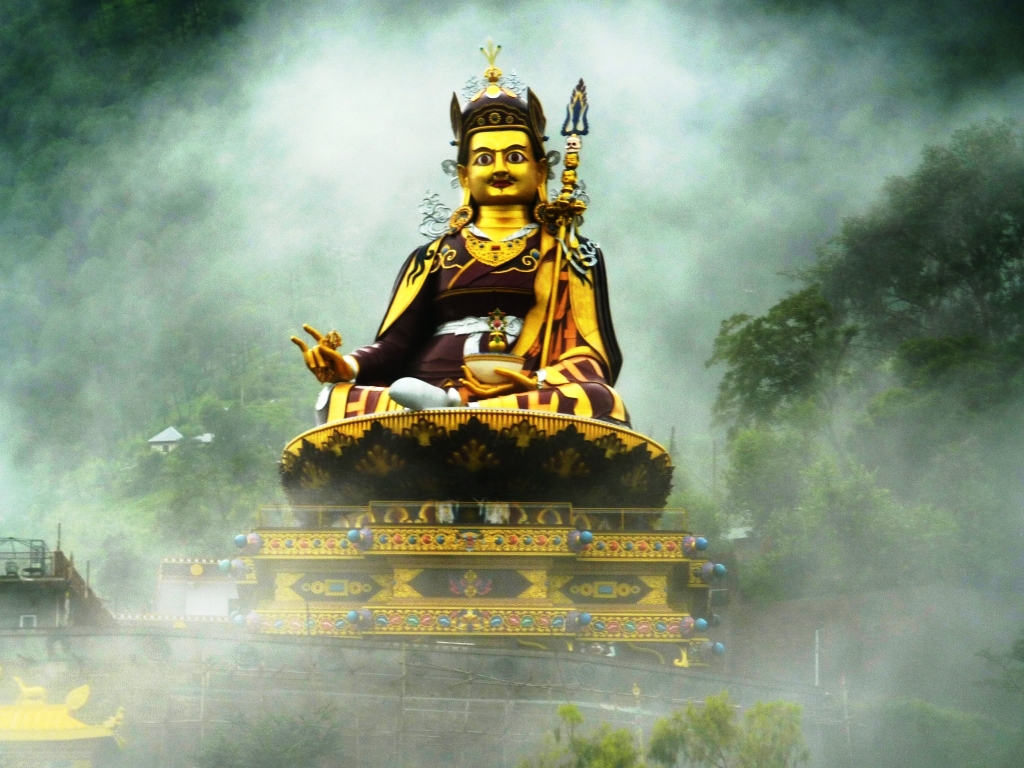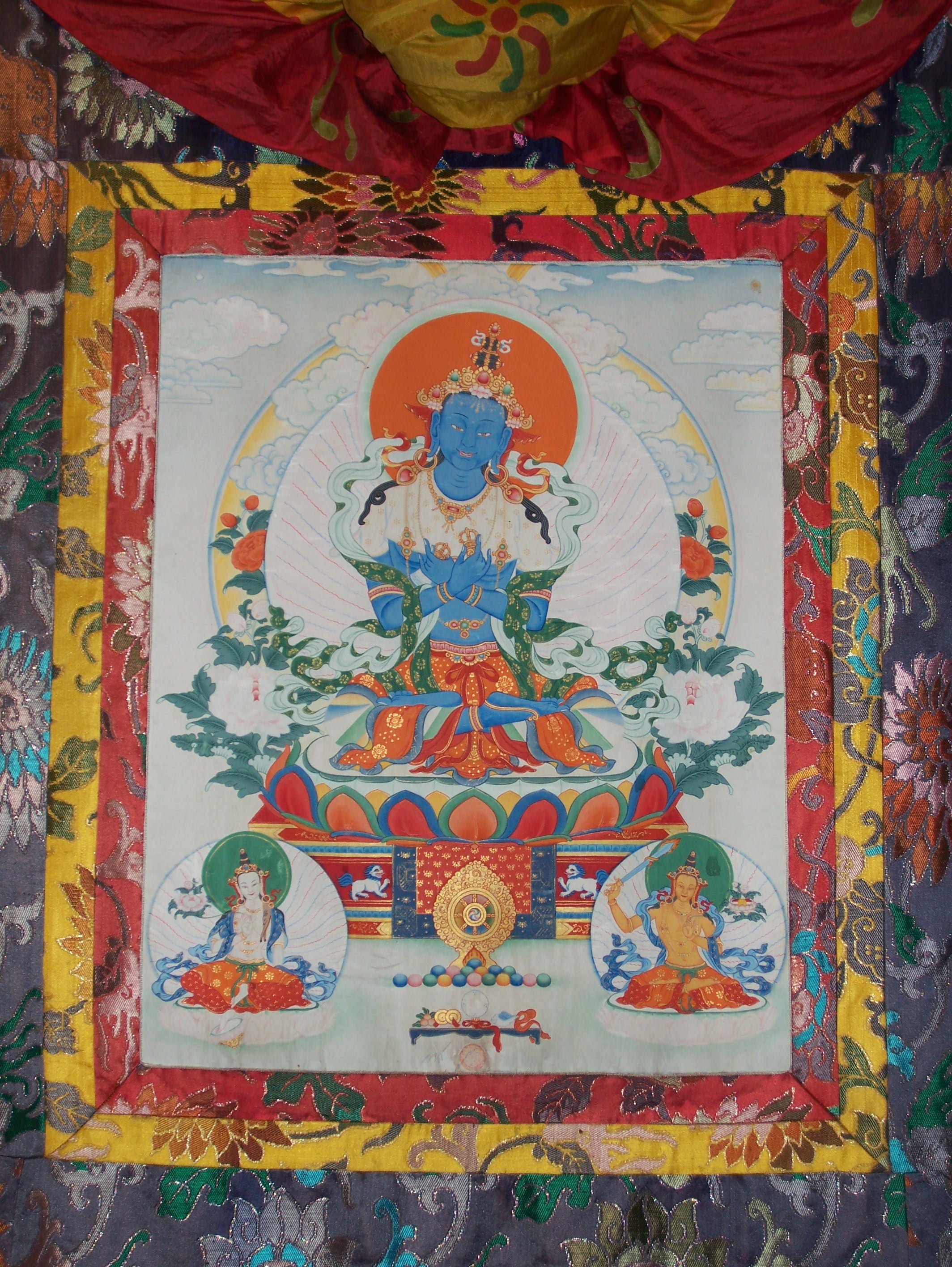|
Niguma
Niguma is considered one of the most important and influential yoginis and Vajrayana teachers of the 10th or 11th century in India. She was a dakini, and one of the two female founders of the Shangpa Kagyu school of Vajrayana Buddhism, along with dakini Sukhasiddhi. Her birth name was Shrijnana (or Palgyi Yéshé in Tibetan). Like many of the mahasiddhas and Tantric practitioners of the time, Niguma was known by several names both during her lifetime and afterwards. She was called Yogini Vimalashri, or Vajradhara Niguma, or Jñana (wisdom) Dakini Adorned with Bone (ornaments), or The Sister referring to her purported relationship to the great Buddhist teacher and adept Naropa. She was also sometimes called Nigupta, which is explained by the historical Buddhist scholar Taranatha as follows: "The name Nigu accords with the Indian language, which is Nigupta, and is said to mean 'truly secret' or 'truly hidden.' In fact, it is the code-language of the dakinis of timeless awareness." ... [...More Info...] [...Related Items...] OR: [Wikipedia] [Google] [Baidu] |
Shangpa Kagyu
The Shangpa Kagyu (, "Oral Tradition of the man from Shang") is known as the "secret lineage" of the Kagyu school of Vajrayana or Tibetan Buddhism and differs in origin from the better known Dagpo Kagyu schools. The Dagpo Kagyu are the lineage of Tilopa through his student Naropa, often traced through Naropa's famous student Marpa Lotsawa and thus called "Marpa Kagyu", while the Shangpa lineage descends from Tilopa's student Niguma, who was Naropa's sister, as well as from the teachings of Sukhasiddhi. Its founder was Khyungpo Naljor, the student of both women, whose monastery in the Shang Valley gave its name to the tradition. The principal Shangpa dharmapala is the six-armed Mahākāla. The Shangpa tradition was revitalized in the 20th century by the first Kalu Rinpoche, who had many students both in Tibet and in the West. Origins The Shangpa Kagyu lineage was founded by the eleventh-century Tibetan scholar Khyungpo Naljor. Seeking to increase his understanding of t ... [...More Info...] [...Related Items...] OR: [Wikipedia] [Google] [Baidu] |
Sarah Harding (lama)
Sarah Harding is a qualified lama and teacher in the Shangpa Kagyu tradition of Tibetan Buddhism. Since 1972, she has been a student and translator of Kalu Rinpoche (1905-1989). Harding completed the first traditional Kagyu three-year three-month retreat three day for westerners under the guidance of Kalu Rinpoche in 1980. Others who participated in that retreat include Richard Barron, Ken McLeod, Ngawang Zangpo (Hugh Leslie Thompson), Ingrid Loken McLeod and Lama Surya Das (Jeffery Miller). Harding works as a teacher, interpreter and translator. She has been an instructor in the Religious Studies Department of Naropa University since 1992 and lives in Boulder, Colorado with her two children. She is currently working on translations of Tibetan Buddhist texts as a fellow of the Tsadra Foundation. Harding has published a book about the 11th Century female teacher Niguma whose teachings are at the core of the Shangpa Kagyu Vajrayana Buddhist Buddhism ( , ), also known a ... [...More Info...] [...Related Items...] OR: [Wikipedia] [Google] [Baidu] |
Naropa
Nāropā ( Prakrit; sa, Nāropāda, Naḍapāda or Abhayakirti) or Abhayakirti was an Indian Buddhist Mahasiddha. He was the disciple of Tilopa and brother, or some sources say partner and pupil, of Niguma. As an Indian Mahasiddha, Naropa's instructions inform Vajrayana, particularly his six yogas of Naropa relevant to the completion stage of anuttarayogatantra. He was also one of the gatekeepers of Vikramashila monastery which is located in Bihar. Although some accounts relate that Naropa was the personal teacher of Marpa Lotsawa, other accounts suggest that Marpa held Naropa's lineage through intermediary disciples only. Names According to scholar John Newman, "the Tibetans give Nāro's name as ''Nā ro pa, Nā ro paṇ chen, Nā ro ta pa,'' and so forth. The manuscript of the ''Paramarthasaṃgraha'' preserves a Sanskrit form ''Naḍapāda'' (''Paramarthasaṃgraha'' 74). A Sanskrit manuscript edited by Tucci preserves an apparent Prakrit form ''Nāropā'', a ... [...More Info...] [...Related Items...] OR: [Wikipedia] [Google] [Baidu] |
Tibet
Tibet (; ''Böd''; ) is a region in East Asia, covering much of the Tibetan Plateau and spanning about . It is the traditional homeland of the Tibetan people. Also resident on the plateau are some other ethnic groups such as Monpa people, Monpa, Tamang people, Tamang, Qiang people, Qiang, Sherpa people, Sherpa and Lhoba peoples and now also considerable numbers of Han Chinese and Hui people, Hui settlers. Since Annexation of Tibet by the People's Republic of China, 1951, the entire plateau has been under the administration of the People's Republic of China, a major portion in the Tibet Autonomous Region, and other portions in the Qinghai and Sichuan provinces. Tibet is the highest region on Earth, with an average elevation of . Located in the Himalayas, the highest elevation in Tibet is Mount Everest, Earth's highest mountain, rising 8,848.86 m (29,032 ft) above sea level. The Tibetan Empire emerged in the 7th century. At its height in the 9th century, the Tibet ... [...More Info...] [...Related Items...] OR: [Wikipedia] [Google] [Baidu] |
Marpa Lotsawa
Marpa Lotsāwa (, 1012–1097), sometimes known fully as Marpa Chökyi Lodrö ( Wylie: mar pa chos kyi blo gros) or commonly as Marpa the Translator (Marpa Lotsāwa), was a Tibetan Buddhist teacher credited with the transmission of many Vajrayana teachings from India, including the teachings and lineages of Mahamudra. Due to this the Kagyu lineage, which he founded, is often called Marpa Kagyu in his honour.samye.orgThe Kagyu Lineage: the Tibetan Lineage Masters: Marpa the Translator/ref> Although some accounts relate that the Mahasiddha Naropa was the personal teacher of Marpa, other accounts suggest that Marpa held Naropa's lineage through intermediary disciples only. Either way, Marpa was a personal student of the Mahasiddha Maitripa and of the dakini Niguma. Biography Born as Marpa Chökyi Lodrö, in Lhodrak Chukhyer in the southern part of Tibet, to an affluent family, he began studying at a young age but was wild and untamed compared to other children. Marpa first receive ... [...More Info...] [...Related Items...] OR: [Wikipedia] [Google] [Baidu] |
Sukhasiddhi
Sukhasiddhi (flourished 11th Century) was an Indian teacher of Vajrayana Buddhism, a yogini and master of meditation. She was born in west Kashmir Kashmir () is the northernmost geographical region of the Indian subcontinent. Until the mid-19th century, the term "Kashmir" denoted only the Kashmir Valley between the Great Himalayas and the Pir Panjal Range. Today, the term encompas ... to a large, poor family. A mother of three sons and three daughters, she once gave a beggar the only food in the house and was expelled from home. She traveled to Oḍḍiyāna, thought to be the land of dakas and dakinis, and there she met Virupa, a mahasiddha who became her guru. Very quickly Sukhasiddhi became completely realized and together with Niguma, as well as Rāhula, Maitripada and Vajrasapana, was the root teacher of the Tibetan yogi Khungpo Naljor, who founded the Shangpa Kagyu school of Tibetan Buddhism. Further reading * * External links Shangpa Networ ... [...More Info...] [...Related Items...] OR: [Wikipedia] [Google] [Baidu] |
Guru Rinpoche
Padmasambhava ("Born from a Lotus"), also known as Guru Rinpoche (Precious Guru) and the Lotus from Oḍḍiyāna, was a tantric Buddhist Vajracharya, Vajra master from India who may have taught Vajrayana in Tibet (circa 8th – 9th centuries)... According to some early Tibetan sources like the ''Testament of Ba'', he came to Tibet in the 8th century and helped construct Samye Monastery, the first Buddhist monastery in Tibet. However, little is known about the actual historical figure other than his ties to Vajrayana and Indian Buddhism. Padmasambhava later came to be viewed as a central figure in the transmission of Buddhism to Tibet. Starting from around the 12th century, Hagiography, hagiographies concerning Padmasambhava were written. These works expanded the profile and activities of Padmasambhava, now seen as taming all the Tibetan spirits and gods, and concealing various secret texts (''Terma (religion), terma'') for future tertöns. Nyangrel Nyima Özer, Nyangral Nyima � ... [...More Info...] [...Related Items...] OR: [Wikipedia] [Google] [Baidu] |
Lawapa
Lawapa or Lavapa () was a figure in Tibetan Buddhism who flourished in the 10th century. He was also known as Kambala and Kambalapada (Sanskrit: ). Lawapa, was a mahasiddha, or accomplished yogi, who travelled to Tsari. Lawapa was a progenitor of the Dream Yoga sādhanā and it was from Lawapa that the mahasiddha Tilopa received the Dream Yoga practice lineage. Bhattacharya, while discussing ancient Bengali literature, proffers that Lawapa composed the '' Kambalagītika'' ( "Lawapa's Song") and a few songs of realization in the '' Charyapada''. Simmer-Brown (2001: p. 57) when conveying the ambiguity of ḍākinīs in their "worldly" and "wisdom" guises conveys a detailed narrative that provides the origin of Lawapa's name: Nomenclature, orthography and etymology Alternate English orthographies are Lwabapa, Lawapa and Lvapa. Simmer-Brown, Judith (2001). ''Dakini's Warm Breath: the Feminine Principle in Tibetan Buddhism''. Boston, USA: Shambhala. (alk. paper): p. 57; p. ... [...More Info...] [...Related Items...] OR: [Wikipedia] [Google] [Baidu] |
Vajradhara
Vajradhara (Sanskrit: वज्रधर. (Also, the name of Indra, because 'Vajra' means diamond, as well as the thunderbolt, anything hard more generally) Tibetan: རྡོ་རྗེ་འཆང། rdo rje 'chang (Dorje Chang); zh, t=金剛總持, p=Jīngāng zǒng chí; Javanese: Kabajradharan; Japanese: 持金剛仏; English: Diamond-holder; Vietnamese: Kim Cang Tổng Trì) is the ultimate primordial Buddha, or Adi-Buddha, according to the Sakya, Gelug and Kagyu schools of Tibetan Buddhism. In the evolution of Indian Buddhism, Buddha Vajradhara gradually displaced Samantabhadra, who is the 'Primordial Buddha' in the Nyingma, or 'Ancient School.' However, the two are metaphysically equivalent. Achieving the 'state of Vajradhara' is synonymous with complete realisation. According to the Kagyu lineage, Buddhā Vajradhara is the primordial Buddha, the Dharmakaya Buddha. He is depicted as dark blue in color, expressing the quintessence of buddhahood itself and represe ... [...More Info...] [...Related Items...] OR: [Wikipedia] [Google] [Baidu] |







